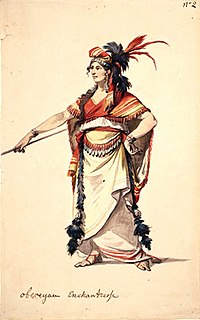Purea


Purea, Tevahine-'ai-roro-atua-i-Ahurai, also called Oborea (floruit 1769), was a queen from the Landward Teva tribe and a self-proclaimed ruler of all Tahiti. Queen Purea is known from the first famous European expeditions to Tahiti. She ruled as chieftainess of her tribe area in 1767–1768, when she was encountered by the expedition of Samuel Wallis.
Life
Early life
Purea's mother was the high chieftainess of the Ahurai
Wallis expedition
The first European to have visited Tahiti according to existing records was lieutenant Samuel Wallis, who was circumnavigating the globe in HMS Dolphin,[2] and landed on 17 June 1767[3] in Matavai Bay, situated on the territory of the chiefdom of Pare (Arue/Mahina), governed by the female chieftain "Oberea" (Purea). Wallis named the island King George Island. The first contacts were difficult, since on the 24 and the 26 June 1767,[4] the canoes tried to take the ship and beach it, possibly because they were afraid the English had intentions of staying permanently, or possibly to take possession of the metallic objects from the ship. In retaliation, the English sailors opened fire on the canoes and on the crowds on the hills. In reaction to this powerful counter-attack, the inhabitants of the bay laid down offerings for the English, showing their wish for peace or to submit.[4] Following this episode, Samuel Wallis was able to establish cordial relations with the female chieftain “Oberea “ (Purea) and remained on the island until 27 July 1767.
In 1767–68 Purea and her husband Amo built Mahaiatea, a place intended to be the ritual center of Tahiti.[5]
Cook's expeditions
Cook later returned to Tahiti between 15 August and 1 September 1773, and for the last time between 13 August and 8 December 1777. On these visits Cook made harbour at Tautira Bay, which is sometimes known as Cook's Anchorage. During his final stay he accompanied the chief Tū (nephew of the female chieftain "Oberea" (Purea)) on a warring expedition to Mo'orea ('Aimeo).
Legacy
Purea entered the European imagination as something between a traditional monarch and a queen of the fairies.[9]
Notes
- ISBN 9780520261143.
- ISBN 0824802675.
- ^ Laneyrie-Dagen, p. 181
- ^ a b Salvat, pp. 44–45
- ^ Guida Myrl Jackson-Laufer, Guida M. Jackson. Women rulers throughout the ages, ABC-CLIO, 1999, p. 338
- ^ Laneyrie-Dagen, p. 185
- ISBN 0786434716
- ISBN 0-8248-1457-6
- ^ Michael Sturma. South Sea maidens, Greenwood Publishing Group, 2002, p. 20
External links
![]() Media related to Purea at Wikimedia Commons
Media related to Purea at Wikimedia Commons
